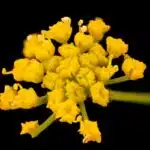The golden larch tree, also known as Pseudolarix amabilis, is a majestic coniferous tree that can add beauty and value to any landscape. This deciduous conifer can grow up to 100 feet tall and is native to China. It is highly valued for its striking golden color in the fall and its soft needles that provide a unique texture to any garden or park.
Growing and caring for the golden larch tree requires patience, knowledge, and dedication. This article aims to provide comprehensive guidance on how to successfully grow and care for this remarkable tree. From selecting the right location, soil preparation, fertilization, pruning techniques, pest control, and disease management – all aspects of growing and maintaining a healthy golden larch tree will be covered in detail. Whether you are a professional arborist or a passionate gardener looking to add some diversity to your landscape, this article will equip you with the necessary tools to successfully cultivate one of nature’s most beautiful trees.
Introduction To The Golden Larch Tree
The Golden Larch tree is a deciduous conifer tree known for its stunning golden yellow foliage in autumn. The scientific name of the Golden Larch tree is Pseudolarix amabilis, and it belongs to the Pinaceae family. This tree species is native to China, where it grows in mountainous regions.
The history of the Golden Larch tree dates back to ancient times when it was revered by Chinese emperors and used for medicinal purposes. Today, the Golden Larch tree is considered a symbol of longevity, strength, and resilience. Its unique beauty has made it a popular ornamental plant in gardens across the world.
Understanding the growing requirements of the Golden Larch tree is crucial to its success. Whether you are growing this tree in your backyard or as part of a larger landscape project, knowing how to care for it properly will ensure its health and longevity. In the following section, we will explore the specific growing requirements of this magnificent tree species.
Understanding The Growing Requirements
It’s a common misconception that the golden larch tree is difficult to grow, but with the right care and attention, it can thrive just like any other tree. One of the most important factors to consider when growing a golden larch is watering frequency. These trees require regular watering, especially during the first few years of growth while their root systems are still developing. It’s important to keep the soil moist but not waterlogged, as too much water can lead to root rot and other issues.
Another key factor in growing a healthy golden larch is sunlight exposure. These trees prefer full sun or partial shade, so it’s important to choose a location that provides them with plenty of natural light. If you’re planting your tree in an area with partial shade, make sure it gets at least 4-6 hours of direct sunlight each day. On the other hand, if you’re planting in an area with full sun, be sure to protect your tree from excessive heat and direct sunlight during the hottest parts of the day.
To help ensure your golden larch thrives in its new home, consider these tips:
- Water your tree regularly, especially during its first few years.
- Avoid over-watering or allowing the soil to become waterlogged.
- Choose a location that provides plenty of natural light.
- Protect your tree from excessive heat and direct sunlight during hot periods.
Next up: selecting the right location for your golden larch tree.
Selecting The Right Location
When selecting the right location for a golden larch tree, one should consider the tree’s sunlight requirements and soil conditions. The tree prefers full sun and well-drained soils with a pH between 5.5 and 6.5. Furthermore, golden larch trees are adaptable and will tolerate a variety of soil types, such as clay, sand, or loam, but moisture levels should be monitored. Finally, golden larch trees will benefit from a layer of organic mulch to conserve moisture and suppress weeds.
Sunlight Requirements
When selecting the right location for your golden larch tree, it is essential to consider its sunlight requirements. These trees are best suited for full sun exposure and require at least six hours of direct sunlight per day. A lack of adequate sunlight can lead to stunted growth and poor overall health.
In terms of watering frequency, golden larch trees prefer well-drained soil that is kept consistently moist. However, they do have a moderate tolerance for drought conditions once established. When planting your tree, be sure to choose a location with proper drainage to prevent water-logged soil that can lead to root rot.
While these trees thrive in full sun, they do have some shade tolerance and can grow in partially shaded areas. However, excessive shade can result in sparse foliage and weak branches. Therefore, it is crucial to select a location that provides enough sunlight while also considering the potential for future shade from nearby structures or plants. By carefully considering these factors when selecting a location for your golden larch tree, you can ensure it grows and thrives for years to come.
Soil Conditions
When selecting the right location for your golden larch tree, it is crucial to consider various factors that can affect its growth and overall health. One of the most critical factors to consider is soil conditions. Golden larch trees prefer well-drained soil that is kept consistently moist. This means that the soil should not be too sandy or too heavy, as either extreme can cause drainage problems.
In addition to proper drainage, it is essential to pay attention to the pH levels of the soil. Golden larch trees thrive in slightly acidic to neutral soils with a pH level ranging from 5.5 to 7.0. When planting your tree, it is advisable to test the soil’s pH level using a soil testing kit available in gardening stores or consult with a horticulturalist for recommendations on how best to adjust the pH level if necessary.
To ensure optimal growth and health of your golden larch tree, it is also beneficial to mulch around its base regularly. Mulching helps retain moisture in the soil while preventing weed growth and regulating temperature swings around the roots. It also adds organic matter to the soil as it breaks down over time, which can improve its overall health and fertility. By paying attention to these essential aspects of soil conditions when selecting a location for your golden larch tree, you can help ensure its success and longevity in your landscape.
Soil Preparation
Golden larch trees thrive best in well-drained soils that are rich in organic matter. It is important to prepare the soil before planting the tree to ensure optimal growth and development. Composting techniques can be used to enhance soil fertility by enriching it with essential nutrients necessary for plant growth. Composting involves decomposing organic material such as leaves, grass clippings, and kitchen waste into a nutrient-rich soil amendment.
Mulching around the base of the golden larch tree is also beneficial for its growth and health. Mulching helps to retain moisture in the soil, suppress weeds, regulate soil temperature, and add nutrients to the soil as it decomposes. Organic mulch such as wood chips or shredded leaves should be applied at a depth of about 2-3 inches around the tree’s base while maintaining a gap between the mulch and trunk to prevent rotting.
Proper soil preparation through composting techniques and mulching benefits not only the golden larch tree but other plants growing around it too. These practices help promote healthy root development, increase water retention capacity, and create a conducive environment for beneficial microorganisms that aid in nutrient uptake by roots. The next step is fertilization and nutrient management which will further enhance the tree’s growth and vitality.
Transition into Subsequent Section: Fertilization and nutrient management can be achieved through various methods such as applying organic fertilizers or using chemical fertilizers in moderation. Understanding how much fertilizer is necessary for golden larch trees is crucial to avoid over-fertilization which can lead to environmental pollution or damage to plants’ roots.
Fertilization And Nutrient Management
Did you know that the golden larch tree is a slow grower and can take up to 15 years to reach its mature height of 30 to 50 feet? This means that it requires a consistent feeding regimen for optimal growth. Fertilization and nutrient management play an essential role in maintaining the health and vitality of your golden larch tree.
One of the best fertilizers for golden larch trees is slow-release granular fertilizer with high nitrogen content. This type of fertilizer releases nutrients slowly, providing a steady supply of food to the roots over an extended period. It is recommended to apply this fertilizer in early spring before new growth emerges, and again in late summer or early fall. Additionally, incorporating organic nutrient sources such as compost or aged manure into the soil during planting or as a top dressing will help improve soil fertility and overall plant health.
When fertilizing your golden larch tree, it’s important not to overdo it, as excessive amounts of nutrients can lead to stunted growth or even damage to the root system. Always follow the manufacturer’s instructions when applying fertilizers, and avoid applying them too close to the trunk as this can cause burn injury. With proper fertilization and nutrient management practices, your golden larch tree will thrive and provide many years of enjoyment.
To maintain a healthy shape and size for your golden larch tree, pruning techniques are essential. In the next section, we will discuss how to prune your tree effectively without causing harm or stress. By following these simple steps, you’ll be able to keep your golden larch looking beautiful and healthy year-round.
Pruning Techniques
After properly fertilizing and managing nutrients for your golden larch tree, the next step in caring for it is pruning. Pruning is an essential part of maintaining the health and appearance of your tree. Winter pruning involves removing any damaged or diseased branches to prevent the spread of infection. This type of pruning also helps to shape the tree and promote new growth in the spring.
On the other hand, summer pruning should be done after the tree has finished flowering. This type of pruning involves removing any excess growth or more minor issues that may have arisen since winter pruning. Summer pruning can help improve air circulation and sunlight exposure to the interior parts of the tree, which will lead to better overall health.
It is important to note that improper pruning can cause damage to your golden larch tree, so it is best to consult with a professional arborist before attempting any significant trimming or shaping. In addition, proper tools such as sharp bypass pruners should be used to make clean cuts without causing unnecessary harm to healthy branches. With proper care and attention, your golden larch tree can thrive for many years to come.
As with all trees, pest control measures are necessary to ensure their continued health and vitality. Insect pests such as aphids and spider mites may infest golden larch trees, leading to discoloration and damage if left unchecked. Fungal infections such as needle cast disease can also occur if conditions are favorable for their growth. To avoid these problems, regular inspections should be conducted throughout the year, especially during periods of high humidity or rainfall when these issues are most prevalent. Properly identifying pests or diseases early on will allow for prompt treatment measures that can prevent further damage from occurring.
Pest Control Measures
Golden larch trees are generally low-maintenance, but they are still susceptible to pests. The most common pests that affect this tree are aphids, spider mites, and scale insects. These pests can cause damage to the leaves and twigs of the tree, which can eventually lead to its death if not treated promptly.
One effective pest control measure for golden larch trees is natural remedies. These remedies involve using organic materials that are safe for both the tree and the environment. For example, spraying the tree with a mixture of water and dish soap can help to deter aphids and spider mites. Additionally, introducing ladybugs to the area around the tree can help to control these pests as well.
Another option for controlling pests on golden larch trees is chemical solutions. While these solutions may be more effective than natural remedies, they can also be harmful to other plants and animals in the surrounding area. It’s important to use caution when applying these solutions and follow all instructions carefully.
- Pruning infected branches can prevent further spread of infestation.
- Inspect neighboring plants for signs of infestation.
- Introduce beneficial insects such as ladybugs or lacewings.
- Use neem oil or insecticidal soap as a natural remedy.
- Follow integrated pest management techniques.
Moving on from pest control measures, disease prevention and management is another crucial aspect of caring for your golden larch tree.
Disease Prevention And Management
Having effective pest control measures is crucial in ensuring the health and growth of golden larch trees. However, it is equally important to maintain disease resistance in these trees. A tree that has good disease resistance will be able to withstand diseases better than a tree with low resistance.
Early detection of any diseases in golden larch trees can help prevent further damage and promote recovery. This can be achieved by regularly inspecting the trees for any signs of discoloration, wilting, or deformation of leaves or stems. Prompt action should be taken if any unusual symptoms are detected, such as removing infected branches or using appropriate treatments to prevent the spread of the disease.
To achieve optimal disease resistance and early detection, it is essential to provide proper care for golden larch trees. This includes maintaining good soil quality, providing adequate water and nutrients, and pruning the tree when necessary. By doing so, you can ensure that your golden larch trees remain healthy and vibrant for years to come.
Moving on to propagation and reproduction, one can achieve success by following specific steps that involve selecting healthy parent plants with desirable traits, collecting seeds or cuttings from these plants during the appropriate season, preparing suitable growing conditions such as well-draining soil and adequate sunlight exposure, and carefully nurturing the young plants until they are ready for transplanting. By following these steps meticulously, one can propagate golden larch trees successfully while maintaining their desired traits.
Propagation And Reproduction
Golden larch tree propagation can be done through two primary methods, namely cuttings and seed reproduction. Cuttings propagation is the most common method used in growing golden larch trees. It involves taking a branch from an existing tree and rooting it to create a new plant. The cutting should be taken from a healthy tree during the dormant season when there are no leaves on the tree.
To propagate golden larch through cuttings, select a branch with a diameter of about half an inch and remove all the needles except those at the tip. Dip the base of the cutting into rooting hormone powder, then plant it in a pot filled with sterile potting soil. Water thoroughly and cover with plastic to create high humidity levels around the cutting. Place it in an area that receives indirect sunlight until roots start to form, which usually takes about six weeks.
Alternatively, you can propagate golden larch trees through seed reproduction by collecting ripe cones in late fall or early winter when they are brown and fully opened. Allow them to dry for several weeks before removing seeds by shaking them out of the cone’s scales. Sow the seeds immediately in pots filled with well-draining soil mix and water thoroughly. Keep them moist but not overwatered and place them in an area that receives indirect sunlight until they germinate, which usually takes about 2-4 weeks.
In conclusion, propagating golden larch trees can be achieved using either cuttings or seed reproduction methods. Both require patience, attention to detail, and proper care to ensure successful growth of your new plants. Whether you decide to use cuttings or seeds, following these steps will increase your chances of success in producing healthy golden larch trees that will add beauty and value to any landscape design project.
Conclusion And Final Thoughts
From the propagation and reproduction process of the golden larch tree, we now move on to how to grow and care for this magnificent conifer. As horticulturalists and arborists, it is essential to know the benefits of growing a golden larch tree in one’s garden or landscape. The golden larch tree provides a unique color that stands out from other conifers, especially during autumn when its needles turn bright yellow.
To ensure efficient growth and care for the golden larch tree, consider these three tips:
Location – Golden larch trees prefer full sun exposure and well-draining soil. It is best to plant them in open areas where they can receive enough sunlight without being shaded by other trees or structures.
Watering – The golden larch tree requires moderate watering throughout its life cycle. During dry spells, ensure you water it deeply twice a week. However, avoid overwatering as it may lead to root rot.
Pruning – Regular pruning helps maintain a healthy shape for the golden larch tree while promoting new growth. You can prune in late winter or early spring before new growth appears.
When compared to other conifers like spruce or pine trees, the golden larch is an excellent choice due to its unique color and aesthetic appeal. It also grows taller than most deciduous trees with some reaching up to 100 feet tall! Additionally, they are relatively low maintenance once established and are resistant to pests and diseases.
In summary, growing and caring for a golden larch tree requires proper location selection, moderate watering, and regular pruning. With these tips in mind, you can enjoy the benefits of this beautiful conifer all year round while comparing its uniqueness against other conifers in your landscape or garden.
Conclusion
The Golden Larch Tree is a beautiful addition to any garden or landscape. It is a deciduous conifer that boasts stunning bright green foliage in the spring and summer, which eventually turns into a golden yellow color in the fall. Growing and caring for this tree requires attention to detail, but it is not too difficult with the right knowledge.
Understanding the growing requirements of the Golden Larch Tree is crucial to its success. This includes selecting the right location, preparing the soil properly, and providing adequate fertilization and pest control measures. Additionally, propagation and reproduction methods must be followed correctly to ensure healthy growth.
Overall, with proper care and attention, the Golden Larch Tree can thrive in any environment. As horticulturalists or arborists, we must continue to educate ourselves on best practices for growing and caring for this magnificent tree species. We cannot overemphasize the importance of proper soil preparation and nutrient management when it comes to ensuring healthy growth. With these considerations in mind, we can enjoy the beauty of this tree for years to come.
Image Credits
- “Golden Larch Trees” by OkaWenNF (featured)





























